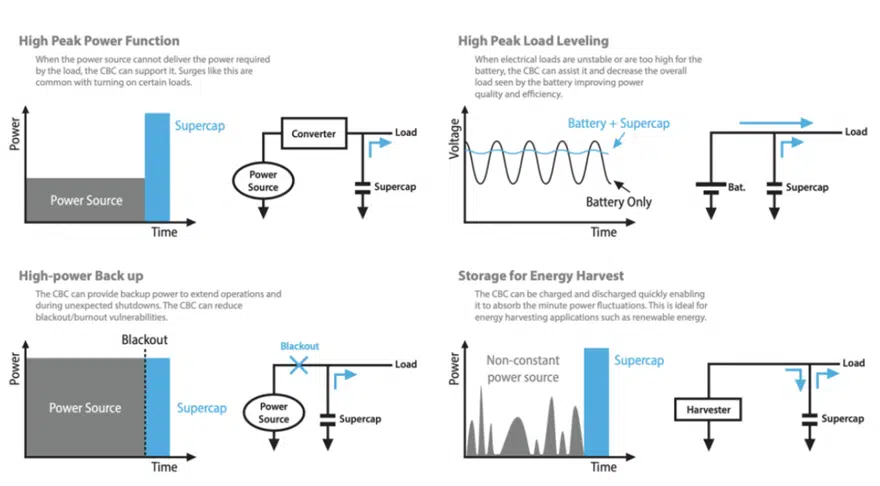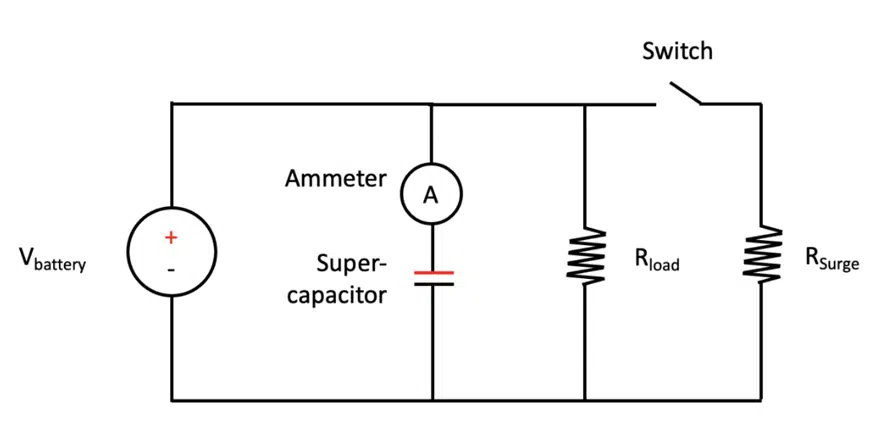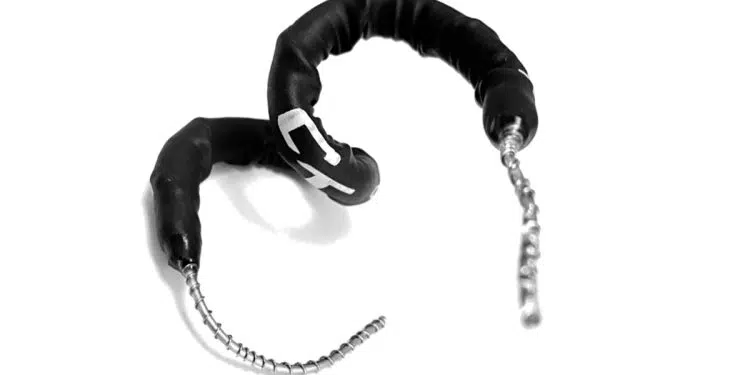There are more ways than one to store energy. Since batteries are currently the most popular, they are a natural point of comparison for other energy storage mechanisms. These alternatives typically do not have the same energy density as batteries but can outperform batteries in one aspect or another. One popular alternative are supercapacitors, which have a significantly higher power density compared to batteries, allowing them to charge and discharge a lot of energy very quickly.
The core benefit of supercapacitors are their:
- Ability to “fast charge” and discharge a lot of energy very quickly, pointing to their high power density.
- Long cycle life as high as 1,000,000 cycles (depending on test characteristics)
- Safe, convenient, and durable operation compared to batteries.
Because of these advantages, supercapacitors are commonly used to provide peak power to complement, balancing loads (especially for power sensitive equipment), providing backup power, and for collecting energy from intermittent sources such as indoor solar cells [1].
While many often focus on the head-to-head comparison of batteries and supercapacitors, a combination of the two has the potential to yield even higher performance than either one can individually [2]. While higher performance is obtainable, the adoption of these hybrid systems has been limited due to their tradeoffs. For supercapacitors, it is critical to balance energy capacity with peak power capability while maintaining a small footprint within the energy storage system. However, if there are space constraints for energy storage systems, there may not be sufficient space to add supercapacitors. Moreover, while the addition of supercapacitors increases peak power capacity (power density), reducing the number of batteries reduces the system’s long-term energy storage capacity (energy density). Thus, designs should always consider the relative advantages and disadvantages of each energy storage technology individually.

Supercapacitors installed on circuit boards have traditionally had a cylindrical or rectangular form factor. While the industry has focused on materials-based innovations such as the adoption of graphene to improve performance of supercapacitors [3], rethinking the form factor has the potential to enable their use in many applications outside of circuit boards, thereby addressing design tradeoffs associated with supercapacitors.

Capacitech’s Flexible Supercapacitors
Capacitech Energy is a high-tech energy storage company that is freeing supercapacitor technologies from the circuit board by reimagining the form factor of supercapacitors. Capacitech’s Cable-Based Capacitor (CBC) is a radically new, flexible, and wire-like supercapacitor optimized for space to help miniaturize electronics and complement power sources lacking peak-power capability, such as batteries and energy harvesting devices. The CBC gives designers more space and design flexibility to meet their customers’ needs. This is because, unlike any supercapacitor before it, the CBC can be routed through areas where space is available on the circuit board or placed off the circuit board and integrated into other parts of the product or system’s infrastructure instead.
The following image represents the use of traditional supercapacitors and CBCs on a printed circuit board (PCB).

In the example above, the CBCs are routed through free space on the PCB to replace the traditional supercapacitors, reducing the PCB size by ~20%. This enables an engineer to miniaturize the circuit design or add new features in the unused area on the circuit board. A taller supercapacitor may have a smaller diameter but will require a larger (taller) housing enclosure. A shorter, or even planar, supercapacitor featuring the same performance can fit into a shorter enclosure, but will require more surface area on the PCB. In off-circuit board use cases, the CBC could be integrated into a product or system’s infrastructure to build a discrete and distributed network of power dense energy storage enabling further miniaturization and design optimization.
Capacitech was initially focused on form factor and manufacturability. Capacitech’s CBC features 3F and is rated to 1.6V. Like traditional supercapacitors, the CBC can be connected in series to meet voltage requirements and in parallel to meet energy storage requirements. This is only the beginning for the CBC. What is available on the market today reflects baseline capabilities, which the company will build upon by adopting higher performance materials and electrolytes over time.
Simple Supercapacitor Demonstration
A simple way to visualize a supercapacitor in application can be seen in the following schematic:

Here, a battery is in parallel with a supercapacitor, a base load, and a surge load that is initially disconnected by a switch. The ammeter in series with the supercapacitor will show the current flow into and out of the supercapacitor.
A common circuit would be a 3.7V-4.2V, 1000mAh, Li-Ion battery in parallel with an ammeter in series with 3 to 10F supercapacitors connected in series to meet the voltage set by the battery, in parallel with a 1kΩ resistor (the base load) to draw ~4mA, in parallel with a 10Ω resistor (the surge load) to draw ~400mA that is initially disconnected by a switch.
The moment the switch is closed, the ammeter will read negative current flow as the supercapacitor immediately responds to the surge in current, before the battery does. This is because the supercapacitor features a low internal impedance. As a result, the supercapacitor protects the battery from the stress of power fluctuations (balancing the circuit). Overtime, the current supplied by the supercapacitor reduces as the battery takes over powering both the load and recharging the supercapacitor.
Cable-Based Capacitor Applications
The CBC is a supercapacitor designed to offer placement advantages that help save space. Capacitech is working with partners for applications such as DC backup power supplies for Wi-Fi routers, 12V auxiliary power supplies for automotive wiring harnesses, shadow protection for solar farms, pairing supercapacitors with energy harvesters to replace batteries in remote internet of things (IoT) applications, and wearables.
Similar to the demonstration in the schematic above, Capacitech is revamping a wearable-IoT application by pairing a flexible solar cell energy harvester with a battery, flexible supercapacitors hidden in the wearable, and an IoT load. When the IoT device is collecting data, it draws very little current. During this time, the solar cells power the IoT device, charge the battery, and charge the supercapacitor. When the IoT device switches to its active mode to transmit data wirelessly via Bluetooth, Wi-Fi, or Cellular networks, a surge of power is needed for a very short period of time (typically less than a second or two). The supercapacitor handles this surge, protecting the battery. The battery is used if the system operates in low light situations (in the shade, at night, or in dimly lit rooms).
This design optimizes runtime for the IoT device by adding solar cells to recharge the battery as well as supercapacitors to protect the battery from power fluctuations, which in turn also optimizes the operating life of the battery. This kind of design is significantly more resilient than a design featuring only batteries or only supercapacitors and gives designers new opportunities too. The supercapacitor in this application is balancing the load, but it could also increase the peak power capability that the IoT device can draw. This may make it possible to transmit data more frequently or send the data over longer distances.
The CBC is better suited than traditional supercapacitors to increase the comfort and streamline the design of the system, by hiding inside the wearable or in the wiring infrastructure connecting solar cells, batteries, and load.
An Ideal Energy Storage System Features Batteries and Flexible Supercapacitors
Supercapacitors have desirable features that are important to energy storage systems. The challenge is finding the physical space to add them without sacrificing other desirable features. Batteries and supercapacitors are designed for different functions and purposes [4]. Batteries have high energy density, allowing them to provide power over a long period of time. However, they cannot deliver this energy quickly and have a limited cycle life. A higher power supply may be needed to level a load or turn on a motor. Even if a battery has the capability to provide this quick burst of energy, it often comes at the expense of reducing its capacity or shortening its operating life. Unlike batteries, supercapacitors are designed specifically to deliver a lot of energy quickly, thanks to a power density approximately 10x that of a battery’s. A battery-supercapacitor hybrid design would allow the battery to be protected from the stress of surge currents and power fluctuations. Together, this design combines the strengths of a battery’s high energy density and a supercapacitor’s ability to meet peak power needs and provide instantaneous current. Together, they have the capacity to outperform an energy storage system featuring only batteries or only supercapacitors.
Typical applications using traditional supercapacitors take up significant space and increase the bulk of the product, a disadvantage for a battery-supercapacitor hybrid. The CBC’s flexibility allows it to be integrated inside the world’s wiring infrastructure, connecting DC sources to their loads. It is the perfect solution to help save space and offer a high-performance energy storage system. The CBC’s ability to complement batteries and be seamlessly integrated into wiring helps engineers and designers overcome tradeoffs to use both batteries and supercapacitors.
Conclusions
Supercapacitors play an important role in energy storage systems and can help foster the next generation of technologies in smart city electronics, wearables, solar power systems, electric vehicles and more.
References
[1] https://www.wevolver.com/article/flexible-supercapacitors-unlock-new-opportunities
[2] https://www.capacitechenergy.com/blog/batteries-vs-supercapacitors-the-answer-is-both
[4] https://ec.kemet.com/blog/supercapacitors-vs-batteries/


































